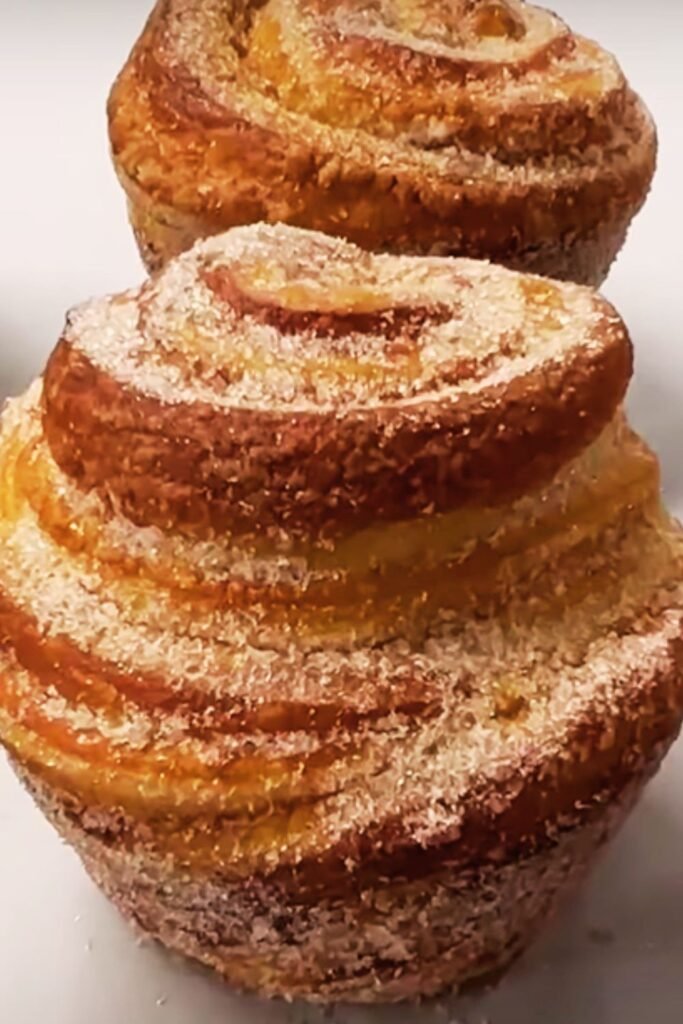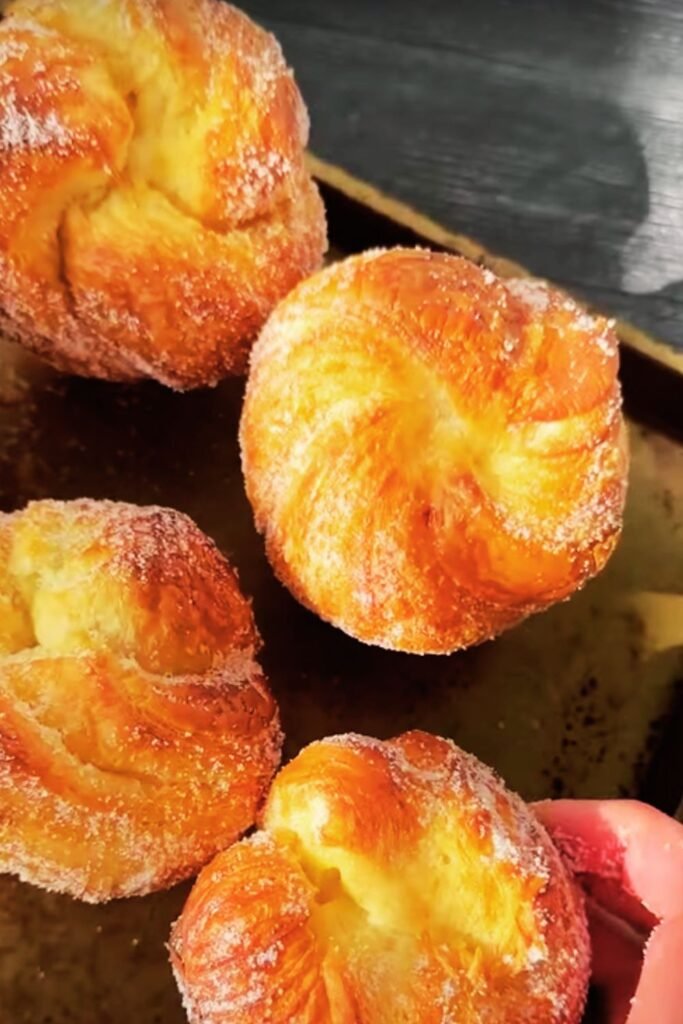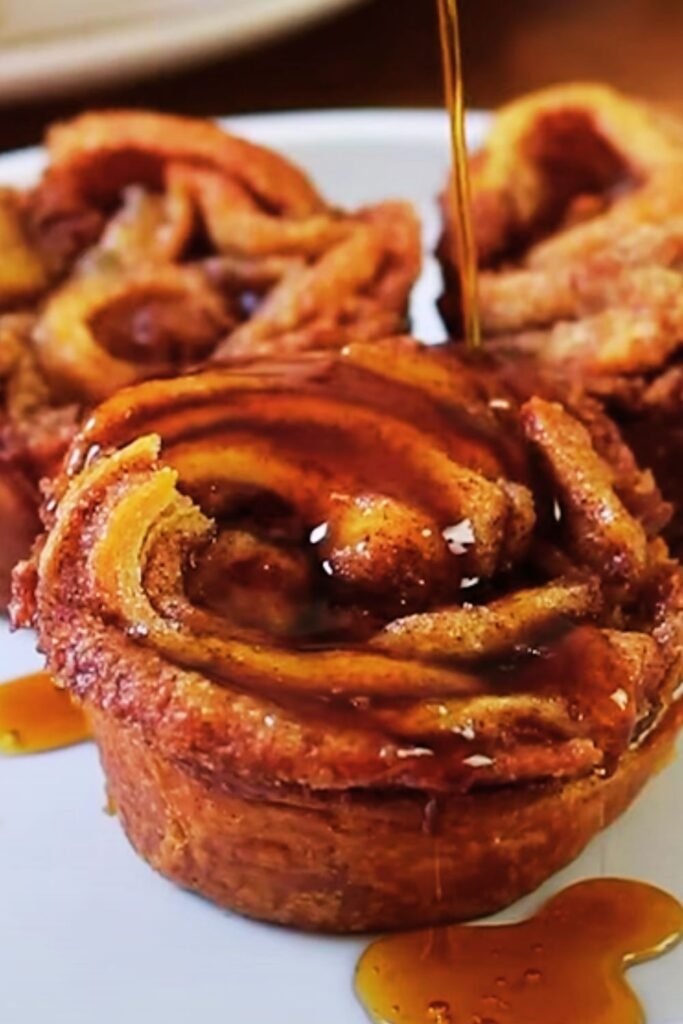I never thought I’d fall head over heels for a pastry that sounds like something straight out of a Dr. Seuss book, but here we are. Cruffins have completely transformed my weekend baking routine, and I’m convinced they’ll do the same for yours. These delightful hybrids combine the buttery layers of a croissant with the convenient shape of a muffin, creating something that’s both familiar and wonderfully surprising.
When I first encountered cruffins at a trendy bakery in San Francisco, I was skeptical. Another food trend trying too hard to be different? But one bite changed everything. The exterior was crispy and golden, giving way to soft, flaky layers that practically melted in my mouth. The filling – a luscious vanilla pastry cream – made me close my eyes and savor every single bite.
What Exactly Are Cruffins?
Cruffin : A hybrid pastry made from croissant dough that’s rolled, shaped, and baked in a muffin tin, creating individual portions with the flaky texture of a croissant in a convenient muffin form.
Laminated Dough : A pastry technique where butter is folded into dough multiple times, creating distinct layers that separate during baking to produce a flaky, airy texture.
Proofing : The final rise period where shaped dough develops flavor and texture before baking.
The beauty of cruffins lies in their versatility. Unlike traditional croissants that require specific shaping techniques, cruffins are surprisingly forgiving. You simply roll out your laminated dough, cut it into strips, coil them into muffin cups, and let the oven work its magic. The result is a pastry that looks impressive but doesn’t require years of French pastry training to master.
Essential Ingredients for Perfect Cruffins
Creating exceptional cruffins starts with understanding your ingredients. I’ve learned through countless batches that quality matters tremendously, especially when working with such a simple ingredient list.
Flour Selection
I always reach for bread flour when making cruffins. The higher protein content gives the dough strength to withstand the multiple folding process while still yielding tender layers. All-purpose flour works in a pinch, but you’ll notice the difference in texture and structure.
Butter Quality
This is where I never compromise. European-style butter with higher fat content creates superior layers and richer flavor. I keep my butter at exactly the right temperature – pliable but not soft. It should bend without breaking when you press it.
Yeast Considerations
Active dry yeast serves me well, but instant yeast works beautifully too. The key is ensuring your yeast is fresh and properly activated. I always test mine in warm water with a pinch of sugar before committing to a full batch.

The Science Behind Laminated Dough
Understanding the science makes all the difference in your results. When I fold butter into dough repeatedly, I’m creating hundreds of alternating layers. During baking, the water in the butter turns to steam, pushing apart these layers and creating that characteristic flaky texture.
Temperature control is absolutely crucial. If the butter gets too warm, it merges with the dough instead of staying in distinct layers. Too cold, and it breaks through the dough, creating holes. I’ve found that maintaining the dough at around 65-70°F throughout the process yields the best results.
Step-by-Step Cruffin Making Process
Preparing the Base Dough
I start by combining my dry ingredients – flour, salt, and a touch of sugar. In a separate bowl, I dissolve the yeast in lukewarm water, then add this to the flour mixture along with softened butter and eggs if using. The dough should come together easily but remain slightly sticky.
After kneading for about 8 minutes by hand or 5 minutes in a stand mixer, the dough becomes smooth and elastic. I shape it into a rectangle, wrap it tightly, and refrigerate for at least 2 hours. This rest period allows the gluten to relax and makes rolling much easier.
The Lamination Process
Here’s where the magic happens. I roll my chilled dough into a large rectangle, then place my prepared butter block in the center. The butter should be pliable – I test this by pressing gently with my finger. It should give slightly without being soft.
I fold the dough over the butter like wrapping a present, then roll it out carefully. The first few passes require gentle pressure to avoid tearing. Once I achieve a long rectangle, I fold it into thirds like a business letter. This completes one “turn.”
After each turn, I mark the dough with gentle finger impressions to track my progress, then wrap and chill for 30 minutes. I repeat this process three times total, giving me hundreds of butter layers.
Shaping and Filling
Once my laminated dough is complete, I roll it into a large rectangle about 1/4 inch thick. Using a sharp knife or pizza cutter, I cut the dough into strips approximately 1 inch wide and 8 inches long.
For filled cruffins, I pipe a small amount of pastry cream or jam along one edge before rolling. Without filling, I simply coil each strip and place it cut-side down in a greased muffin cup. The spiral should sit snugly but not be compressed.

Comprehensive Cruffin Recipe Variations
| Flavor Variation | Main Ingredients | Prep Time | Baking Notes |
|---|---|---|---|
| Classic Vanilla | Pastry cream, vanilla extract | 4 hours | Brush with egg wash for golden color |
| Chocolate Hazelnut | Nutella, chopped hazelnuts | 4 hours | Reduce oven temp by 25°F to prevent burning |
| Cinnamon Sugar | Brown sugar, cinnamon, butter | 3.5 hours | Sprinkle topping after first 10 minutes |
| Lemon Curd | Fresh lemon curd, lemon zest | 4 hours | Cover with foil if browning too quickly |
| Strawberry Cream | Fresh strawberries, vanilla cream | 4.5 hours | Add fruit after initial baking time |
| Maple Pecan | Maple syrup, toasted pecans | 4 hours | Brush with maple glaze while warm |
Nutritional Information and Serving Sizes
| Nutrient | Per Cruffin (Average) | Daily Value % |
|---|---|---|
| Calories | 285 | 14% |
| Total Fat | 18g | 23% |
| Saturated Fat | 11g | 55% |
| Cholesterol | 65mg | 22% |
| Sodium | 240mg | 10% |
| Total Carbs | 26g | 9% |
| Fiber | 1g | 4% |
| Sugar | 8g | – |
| Protein | 6g | 12% |
These values vary significantly based on fillings and toppings. Fruit-filled versions tend to be slightly lower in fat but higher in sugar, while nut-based fillings increase both calories and protein content.
Troubleshooting Common Cruffin Problems
Dough Tears During Rolling
This usually indicates the butter is too cold or the dough hasn’t rested enough. I let both components come to the same temperature and ensure adequate resting time between folds.
Butter Leaks Out
Temperature mismatch is the culprit here. The butter should be pliable but not soft. I test by pressing gently – it should give without melting on my finger.
Dense, Heavy Texture
Insufficient lamination or overworked dough typically causes this. I ensure I complete all three folds and avoid excessive handling after shaping.
Uneven Baking
Oven hot spots or overcrowded pans lead to uneven results. I rotate my pans halfway through baking and ensure adequate space between cruffins.

Storage and Reheating Guidelines
Fresh cruffins are absolutely divine, but proper storage ensures you can enjoy them for days. I store cooled cruffins in an airtight container at room temperature for up to three days. For longer storage, I wrap them individually and freeze for up to one month.
Reheating requires careful attention to restore that crispy exterior. I preheat my oven to 350°F and warm the cruffins for 3-5 minutes. Avoid microwaving, which makes them soggy and tough.
Flavor Pairing and Serving Suggestions
The versatility of cruffins makes them perfect for various occasions. For breakfast, I pair vanilla or cinnamon versions with fresh coffee or black tea. The rich, buttery texture complements the bitter notes beautifully.
Afternoon tea calls for more delicate flavors – lemon curd or strawberry cream work wonderfully. I often serve these with fresh berries and a dollop of whipped cream for an elegant presentation.
For special occasions, chocolate variations shine. I drizzle them with ganache or dust with powdered sugar for an impressive dessert that rivals any fancy patisserie creation.
Seasonal Variations and Creative Fillings
Spring brings opportunities for fresh herb and citrus combinations. I love incorporating lemon thyme or orange zest into the dough itself. Fresh strawberry or rhubarb fillings capture the season’s bright flavors perfectly.
Summer calls for stone fruit fillings – peach, apricot, or plum work beautifully. I sometimes add fresh basil or mint for unexpected complexity. Berry combinations become especially appealing when local fruit is at its peak.
Fall transforms my cruffin making with warm spices and seasonal produce. Apple cinnamon, pumpkin spice, and maple combinations become regular features. I often incorporate toasted nuts for added texture and richness.
Winter demands comfort – rich chocolate, warming spices, and dried fruit combinations. Orange and cranberry, spiced pear, or eggnog-inspired fillings satisfy those cold-weather cravings.
Advanced Techniques for Expert Results
Creating the Perfect Lamination
Temperature consistency throughout the process makes the biggest difference. I use an infrared thermometer to monitor my dough and butter, maintaining them within a few degrees of each other.
Achieving Optimal Rise
Proper proofing transforms good cruffins into exceptional ones. I look for the dough to increase by about 50% in size, which typically takes 45-60 minutes in a warm environment. Under-proofed cruffins remain dense, while over-proofed ones collapse during baking.
Professional Finishing Touches
A proper egg wash creates that bakery-quality golden color. I whisk one egg with a tablespoon of cream and brush gently over the surface just before baking. For sweet versions, a light dusting of pearl sugar adds delightful crunch.
Equipment Recommendations and Alternatives
| Equipment | Professional Choice | Budget Alternative | Why It Matters |
|---|---|---|---|
| Rolling Pin | Heavy marble pin | Wooden dowel pin | Even pressure distribution |
| Bench Scraper | Metal with ruler | Plastic scraper | Clean cuts, easy handling |
| Muffin Pan | Heavy gauge aluminum | Non-stick steel | Even heat distribution |
| Kitchen Scale | Digital, 0.1g precision | Basic digital scale | Consistent measurements |
| Thermometer | Instant-read digital | Basic probe type | Temperature accuracy |
Q&A Section
Q. How long does it take to make cruffins from start to finish?
The entire process takes about 6-8 hours, but most of that is passive time for chilling and rising. Active work time is roughly 45 minutes spread throughout the day. I usually start the dough in the morning and have fresh cruffins by late afternoon.
Q. Can I make the dough ahead of time?
Absolutely! The laminated dough actually improves with time. I often prepare it up to two days in advance and keep it refrigerated. The extended cold fermentation develops more complex flavors.
Q. What’s the best way to tell when cruffins are properly baked?
They should be deep golden brown and sound hollow when tapped gently on the bottom. Internal temperature should reach 190°F if you’re using a thermometer. The layers should be visible and well-separated.
Q. Why do my cruffins sometimes collapse after baking?
This usually indicates under-baking or over-proofing. Make sure they’re fully baked through and avoid letting them rise too long before baking. The structure needs to set completely to maintain its shape.
Q. Can I use different types of flour?
While bread flour gives the best results, all-purpose flour works adequately. Avoid cake flour as it lacks the protein structure needed for lamination. Some bakers successfully use a blend of bread and pastry flour for a more tender texture.
Q. How do I prevent the butter from melting during lamination?
Keep everything cool and work quickly. If the butter starts to soften, wrap the dough and refrigerate for 20-30 minutes before continuing. I sometimes work in an air-conditioned room during hot weather.
Q. What’s the secret to achieving distinct layers?
Consistent butter temperature and gentle handling are key. Don’t roll too aggressively, and make sure to seal the edges well during folding. Each fold should be precise and even.
Q. Can cruffins be made without eggs?
Yes, though they’ll have a slightly different texture. You can substitute with additional liquid or even use aquafaba for a vegan version. The results are still delicious, just less rich.
Creating perfect cruffins has become one of my greatest baking joys. The process requires patience and attention to detail, but the results are absolutely worth every minute invested. Each batch teaches me something new, and the satisfaction of pulling a tray of golden, flaky cruffins from the oven never gets old.
The beauty of this pastry lies not just in its impressive appearance or delicious taste, but in its ability to bring people together. Whether I’m serving them at a weekend brunch or packaging them as gifts for neighbors, cruffins never fail to spark conversation and smiles.
Start with the basic recipe, master the techniques, then let your creativity run wild with fillings and flavors. Before long, you’ll have your own signature variations that friends and family will request again and again. The journey from simple dough to spectacular pastry is one of the most rewarding adventures in home baking.